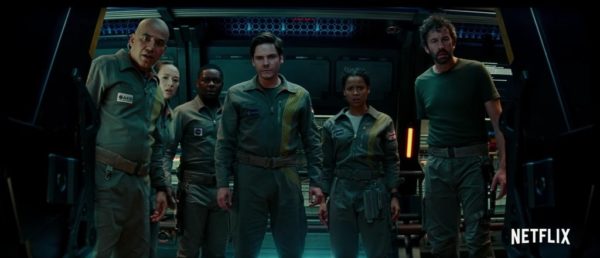In 2008, Matt Reeves and J. J. Abrams released the successful but relatively self-contained Cloverfield. Its intimate perspective and self-restraint in showing the “Clover monster” didn’t enrapture everyone, but I grew to love its style and scale. The bigger surprise came in 2016, when 10 Cloverfield Lane turned it into a (slimline) anthology.
But since 2012, there have been rumblings of a true Cloverfield sequel. Paramount and Abrams have spent years teasing the project, dubbed The God Particle, but its production had been shrouded in fog and seemingly headed for the rocks. And then last night happened.
Not only does The God Particle have a new name, but it’s available right now on Netflix. The Cloverfield Paradox was announced and released in the space of a few hours, and it’s quite a shock: a $45 million film with a star-studded cast and backed by Abrams’ Bad Robot production company, disappearing from the public eye and resurfacing on a streaming service.
Unfortunately, the film itself leaves a lot to be desired. Where Abrams’ previous films have been believable and contemporary, Paradox is high-concept science fiction through and through. With a setup erring uncomfortably close to Danny Boyle’s Sunshine, this film feels more like a B-movie masquerading as something more rather than a true, thematic follow- up to its namesake.
A ravaged Earth, sucked dry of resources and racked by international conflict; a last-ditch attempt to prolong humanity’s existence; a team of top scientists and engineers from around the world that, ultimately, reflects the political situation below. It’s a cheesy popcorn flick, saved from outright disaster by solid performances from the likes of Daniel Brühl, Gugu Mbatha-Raw and David Oyelowo. Dialogue is rife with sci-fi conventions and as-you-and-I-know syndrome—characters already well aware of their own situation spend excruciating amounts of time explaining things to one another.
The way the film plays with and visualises quantum physics and scientific mishaps is satisfying, if not especially new. Chris O’Dowd’s Captain Mundy is a likeable foil to the more scientifically-minded crew members, but the film suffers from a small dose of “cinematic science”. It never really goes hard on the facts, as films like Interstellar and Primer have dared to do.
 Cinematography is bland and set-design forgettable, lacking the clever use of lighting or hard-to-place technology that made films like Alien and 2001: A Space Odyssey. People reacted strongly to Cloverfield’s overzealous shakycam and civilian aesthetic, but this film feels almost too clean. It’s a visually sterile and safe film that becomes a blur of blues and reds. Fortunately, Bear McCreary’s score is sweeping and textured, providing more life to each scene than the wonky editing and camera work.
Cinematography is bland and set-design forgettable, lacking the clever use of lighting or hard-to-place technology that made films like Alien and 2001: A Space Odyssey. People reacted strongly to Cloverfield’s overzealous shakycam and civilian aesthetic, but this film feels almost too clean. It’s a visually sterile and safe film that becomes a blur of blues and reds. Fortunately, Bear McCreary’s score is sweeping and textured, providing more life to each scene than the wonky editing and camera work.
I’m not entirely sure what my expectations of a new Cloverfield film should have been, but the ties to the original feel forced at best and distracting at worst. It’s difficult to place on a chronological timeline, but the Clover monster is a tertiary threat and only loosely relevant to the overall story. There is potential for a follow up film, but the weaknesses in Paradox don’t fill me with confidence.
The Cloverfield Paradox is, in the end, a little more than the sum of its parts. It’s an enjoyable watch that doesn’t stick i the mind like the first film did, but the characters are memorable and the narrative is fun. Its release on Netflix was briefly surprising, but understandable having watched it, as stilted dialogue and mixed-bag production drag down an otherwise decent film.




